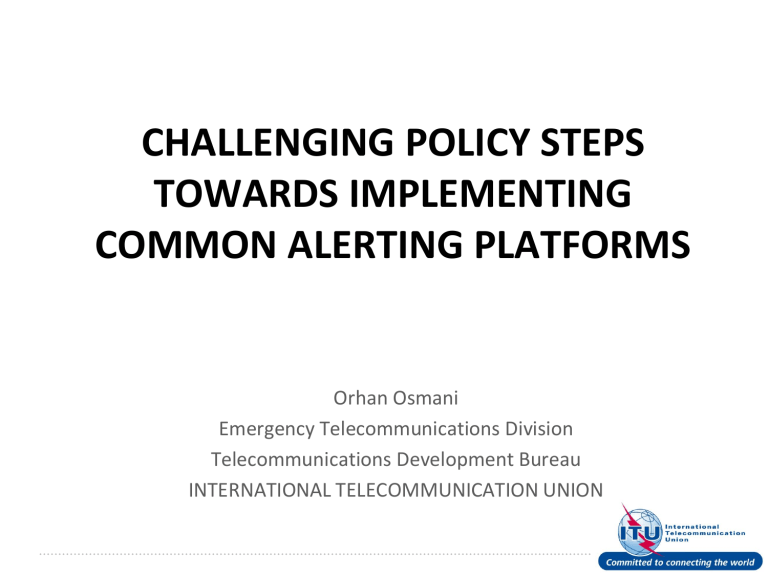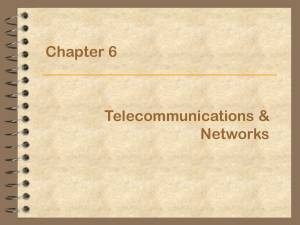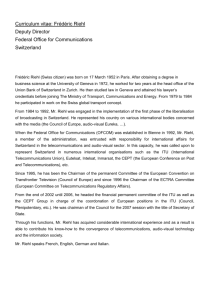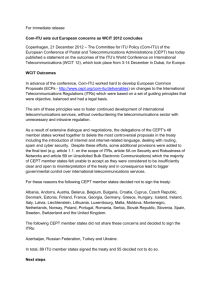Orhan Osmani

CHALLENGING POLICY STEPS
TOWARDS IMPLEMENTING
COMMON ALERTING PLATFORMS
Orhan Osmani
Emergency Telecommunications Division
Telecommunications Development Bureau
INTERNATIONAL TELECOMMUNICATION UNION
International
Telecommunication
Union
Contents
About ITU
Challenges
Current Practices
An Implementation Roadmap
Why an Implementation Roadmap?
Benefits
The Role of ITU
Conclusion
ITU is the oldest UN specialized agency
Founded in 1865 (147 years old)
Committed to connecting the World
ITU-HQ is in Geneva, Switzerland
193 Member States and 700 Sector Members and
Associates.
Over 750 employees, from more than 80 nationalities.
Organized in three Sectors:
–
Radiocommunication (ITU-R)
–
Standardization (ITU-T)
–
Development (ITU-D)
3
Telecommunications Development
Bureau
Neutral broker for multi-stakeholder partnerships, resource mobilization
Executing arm for project implementation
Building capacity among members: technical assistance, advice and guide on policy-regulatory frameworks
Statistics and policy/regulatory trends
Telecommunications Technology and Network
Development
ICT Applications (e-Applications)
Cybersecurity and Child Online Protection
Climate Change and e-Waste Management
Emergency Telecommunications
Emergency Telecommunications Division
Provide technical assistance to member states through different phases of disaster management
(providing satellite telecommunications equipment and technical support on site)
Assist Member States on project design and implementations such as: Early Warning Systems,
Remote Sensing, etc.
Conduct Capacity Building Workshops
Assist Member States on development of
Emergency Telecommunications Plans and
Review the existing
Challenges
Lack of Awareness
Institutional and Human Capacity Building
Policy Development and Implementation
Defining who is the Authority (Leading
Organization)
Information Sharing, Collaboration and
Cooperation
Unclear Definition of Jurisdiction and
Responsibility
Governance and Funding
Current Practices
When implementing a CAP these are some of the practices:
Setting policies to adopt CAP within a country
Establishing a Registry of Alerting Authorities
National CAP Profile Development
Capacity Building on CAP and Alerting Procedures
Ensure CAP Implementation for Interoperability
An Implementation Roadmap
A proposed roadmap to be considered as a model
1.
Drafting and Passing Legislation/Policy
2.
Establish an Organizational Entity – Registry Authority
3.
Adopt Technical Standards and Solutions, Implement
Sound Processes and Standard Operating Procedures
4.
Design and Implement Human and Institutional Capacity
Building Programme
5.
Nurture International Cooperation and Information
Sharing
Why an Implementation Roadmap?
Streamlines implementation processes
Provides clarity and structured approach
Builds a strong foundation for implementation of
CAP
Promotes collaboration on national, regional and international levels
Strengthens political support for implementation
Benefits
Implementation of CAP Standard to Ensure
Interoperability
Affirms the Scope and Jurisdiction through
Legislation and Implemented Processes
Establishes foundation for Governance
Provides a platform for Collaboration and
Cooperation
Presents New Funding Opportunities
The Role of ITU
Establish Partnerships for Implementation
Awareness Creation
Capacity Building on HOW and WHAT
Establish Clarity of Terminology
Together with Partners, Member States and Sector
Members to amend and update X.1303
Recommendation to reflect new developments in the area of alerting
To promote X.1303 : CAP Recommendation for adoption and implementation
Conclusion
A continued Awareness Creation is key to
Promote CAP Implementations
An agreed Implementation Roadmap
Commitment and Partnerships
Funding and Capacity Building
Continued Improvements to CAP processes
THANK YOU
bdtemergencytelecom<at>itu.int









